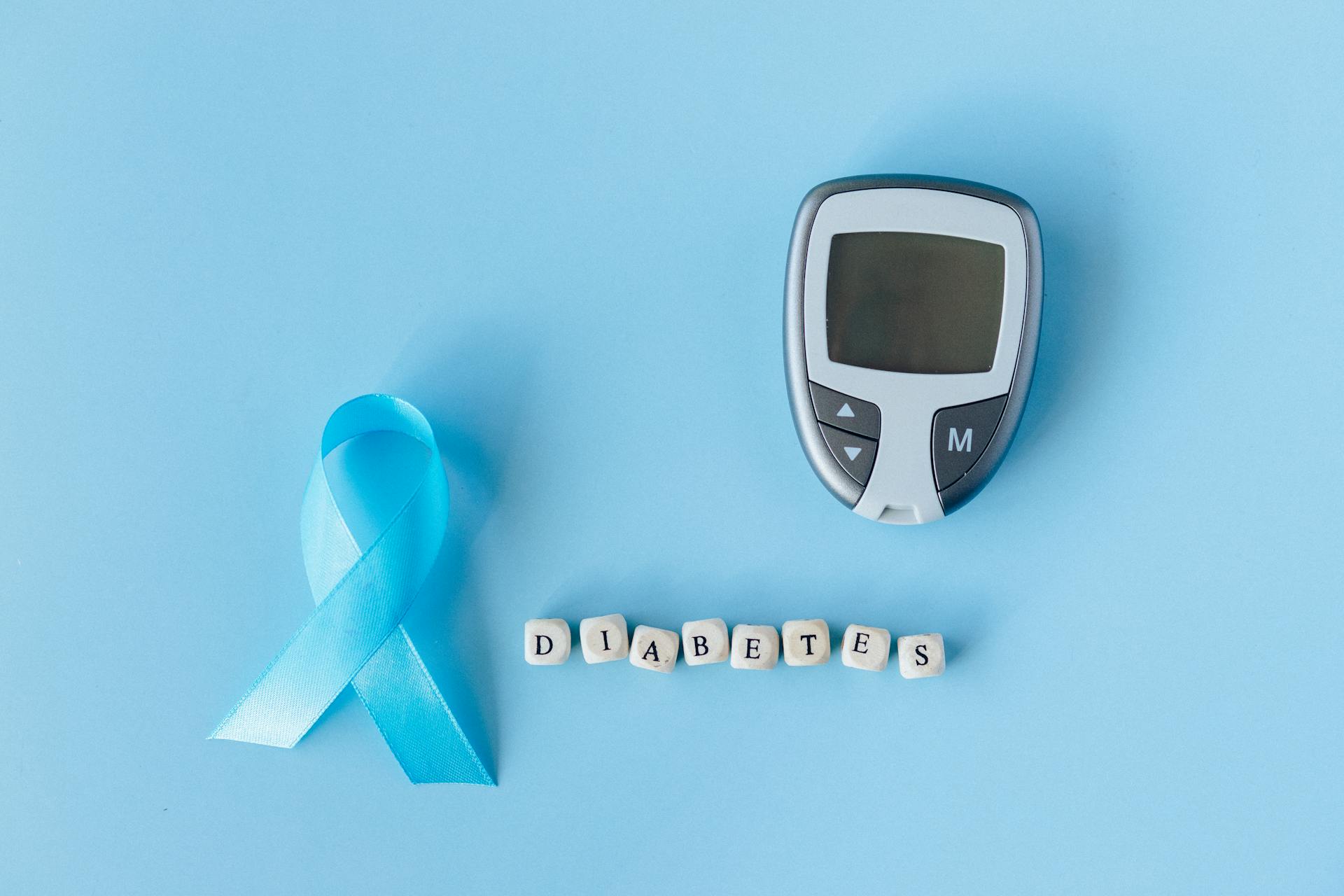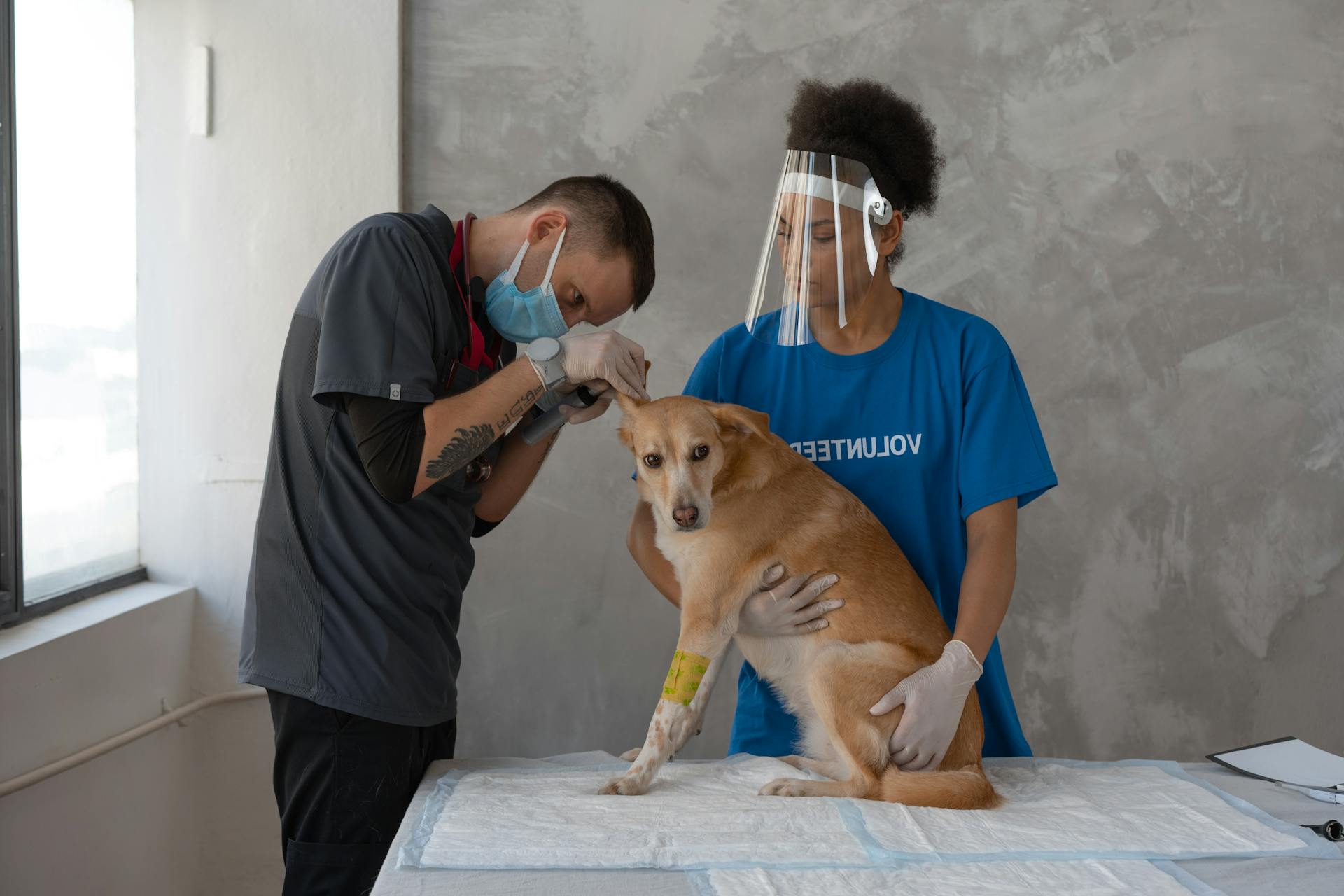
Dogs can live with diabetes, but it requires careful management to prevent complications.
Some dogs can develop insulin resistance, which makes it harder for their bodies to use insulin effectively.
With proper care, dogs with diabetes can lead happy and healthy lives.
Medications such as insulin and oral medications can help regulate blood sugar levels.
What Is Diabetes in Dogs
Diabetes in dogs is a disease that affects the breaking down of sugar (glucose) in the body.
Insulin is a key hormone made in the pancreas that helps the body's cells absorb glucose, which they use as an energy source.
Diabetic dogs either produce too little insulin or their cells don't respond as effectively to insulin as before.
This causes too much glucose in the blood, especially after meals, leading to a condition known as hyperglycaemia.
A different take: Boston Terrier Body
Diagnosis and Treatment
Diagnosis of diabetes in dogs typically involves a combination of clinical signs, blood work, and urinalysis. Your veterinarian may perform additional tests to rule out coexisting conditions such as pancreatitis.
Diabetes can be confirmed by a high blood sugar level, the presence of sugar in the urine, increased thirst and urination, and weight loss despite a good appetite. Your veterinarian may also perform a biochemistry profile, complete blood count, abdominal ultrasound, urine culture, and additional hormonal tests to evaluate the health of your dog.
In severe cases of diabetes, dogs can develop diabetic ketoacidosis, a medical emergency that requires immediate treatment. Diagnosis of ketoacidosis is based on blood glucose levels, ketones in the urine, and clinical signs such as lethargy, vomiting, weakness, dehydration, depression, and rapid breathing.
The goals of controlling dog diabetes are to consistently maintain blood glucose levels within the normal range or just slightly higher than that, avoid spikes and drops in blood glucose levels throughout the day, and correct or reduce the symptoms of diabetes.
For your interest: Blood Sugar Levels for Dogs with Diabetes
What Are the Symptoms?
As a dog owner, it's essential to know the symptoms of diabetes in dogs to catch the issue early. Increased thirst, or polydipsia, is a common symptom, with dogs drinking more water than usual, typically around 50-100ml/kg of body weight each day.

Keep an eye on your dog's water intake and refill their bowl accordingly. If you notice they're drinking more than usual, it could be a sign of diabetes.
Dogs with diabetes may also urinate more frequently, or have a higher volume of urine. Take note of how often your dog goes to the bathroom and compare it to their usual habits.
Increased appetite, or polyphagia, is another symptom to look out for. Diabetic dogs may eat more than usual, which can lead to weight gain or loss over time.
Cataracts, or "cloudy eyes", can also be a sign of diabetes in dogs. These bluish-grey opacities can develop in both eyes and may affect your dog's vision over time.
Recommended read: Dogs Eye Swollen from Allergies
What Are the Types?
There are two main types of diabetes in dogs: Type I and Type II. Type I diabetes is more common in dogs and is also known as "insulin deficiency diabetes" or "insulin-dependent diabetes".

Dogs with Type I diabetes are completely unable to produce insulin in the presence of high glucose levels, leading to high blood glucose levels and very low insulin levels.
Type II diabetes, on the other hand, is more common in cats, but it can still develop in dogs. It's also known as "insulin resistance diabetes".
Dogs with Type II diabetes are able to produce insulin, but the insulin is insufficient for the demand. This means their cells are less responsive to insulin, requiring even higher insulin levels to bring the blood glucose levels down to a normal range.
Here are the key differences between Type I and Type II diabetes in dogs:
How a Vet Diagnoses
A vet will evaluate clinical signs, blood work, and a urinalysis to diagnose diabetes in dogs. They may also perform additional tests to rule out coexisting conditions like pancreatitis.
Your vet may ask to take a urine sample to check for glucose and ketones in the urine. This is a crucial test, as it can help confirm a diagnosis of diabetes.
To officially diagnose diabetes, veterinarians must find persistent high blood and urine glucose values. This means that a single test result is not enough to confirm a diagnosis.
Here are some of the diagnostic tests your vet may perform:
- Urinalysis: to check for glucose and ketones in the urine
- Blood test: to check for high levels of glucose in the blood
- Blood chemistry and complete blood count (CBC): to evaluate the health of your dog
- Fructosamine: to differentiate a stress response from true diabetes
- Abdominal ultrasonography: to evaluate the health of your dog's pancreas and other organs
If your vet suspects that your dog is diabetic, they may also perform other tests such as radiography, thyroid tests, Cushing's testing, and pancreatitis blood testing. These tests can help rule out other conditions and ensure an accurate diagnosis.
Treatment
Treating diabetes in dogs requires a multi-faceted approach that involves medication, lifestyle changes, and regular monitoring. The primary goal is to maintain stable blood glucose levels, which can be achieved through insulin injections and dietary modifications.
Regular insulin injections are usually necessary to control blood sugar levels, with most dogs requiring shots twice a day. The type and dosage of insulin will depend on the individual dog's needs and response to treatment. Consistency is key, so it's essential to give insulin injections at the same time every day.

Dietary changes are also crucial in managing diabetes in dogs. A low-fat, high-fiber diet with complex carbohydrates can help regulate blood sugar levels. Your veterinarian may recommend a specific diet or make adjustments to your dog's current diet to achieve the best results.
Exercise is another vital aspect of managing diabetes in dogs. Regular, moderate exercise can help maintain stable blood glucose levels and improve overall health. However, it's essential to avoid sudden spikes or drops in glucose levels, which can be triggered by intense exercise.
Here are some general guidelines for insulin injections:
- Inject insulin under the skin, typically twice a day, 12 hours apart
- Give insulin after meals to prevent low blood sugar
- Choose a consistent location for injections to avoid scar tissue
- Use a fresh syringe and needle for each injection
It's also essential to monitor your dog's response to treatment and make adjustments as needed. This may involve working closely with your veterinarian to fine-tune your dog's treatment plan.
Related reading: Can You Pierce a Dog's Nose?
Managing Diabetes
Managing diabetes in dogs requires a lot of work, but it's a crucial part of keeping your furry friend healthy. As an owner, you'll need to assume responsibility for providing your dog with daily insulin injections, monitoring for signs of imbalance, and complications like ketoacidosis.
You'll need to learn how to administer insulin injections, which your veterinarian will show you how to do. Insulin requires refrigeration at all times, so you'll need to take that into consideration when traveling with your dog. Most dogs adapt well to injections, but it's essential to follow your veterinarian's instructions carefully.
Monitoring your dog's symptoms is also crucial. Keep an eye out for changes in their thirst, urination, weight, and appetite, and administer at-home glucose tests to track their glucose levels. Your veterinarian may also suggest regular glucose curves in-clinic to further monitor the efficacy of the insulin injections.
Here are some essential tips to help you manage your dog's diabetes:
- Give insulin injections at the same time every day, about 12 hours apart.
- Feed your dog the same food, around the same time every day, to maintain consistency.
- Provide a moderate but consistent exercise routine to help avoid sudden spikes or drops in glucose levels.
- Monitor your dog for signs of low blood sugar, such as weakness, poor appetite, confusion, tremors, or seizures.
- Keep a record of your dog's glucose levels, insulin doses, and any changes in their symptoms to track their progression.
Remember, managing diabetes in dogs requires patience, dedication, and teamwork with your veterinarian. With the right care and attention, your dog can live a happy and healthy life.
Complications and Risks
Diabetes can cause a double whammy in a dog's body, leading to multi-organ damage due to high sugar levels in the bloodstream.
The body's cells are starved for vital fuel, causing muscle cells and certain organ cells to break down their own fats and proteins to use as alternative fuel.
This can lead to a range of complications, including loss of appetite, lack of energy, depressed attitude, and vomiting.
Some of the organs commonly affected by high sugar levels include the kidneys, eyes, heart, blood vessels, or nerves.
Here's a summary of some of the potential complications of diabetes in dogs:
- Loss of appetite
- Lack of energy
- Depressed attitude
- Vomiting
Ketoacidosis Signs
Weight loss is a common sign of diabetic ketoacidosis in dogs, so if you notice your furry friend shedding pounds despite eating normally, it's time to call the vet.
Nausea and vomiting are other warning signs, and if your dog is consistently losing its appetite, it could be a sign of ketoacidosis.
Dehydration is a serious risk, so if your dog is urinating more frequently than usual and seems lethargic, it's a good idea to get it checked out.
Take a look at this: Why Do Yorkshire Terriers Lick so Much
Here are some signs of diabetic ketoacidosis to look out for:
- Weight loss
- Weakness (lethargy)
- Nausea
- Vomiting
- Loss of appetite (anorexia)
- Increased frequency of urination (polyuria)
- Dehydration
If your dog is bright, alert and well-hydrated, hospitalization may not be required, but it's always best to consult with a vet to determine the best course of action.
Check this out: Best Dog Food for Gassy Dogs
What's the Prognosis?
The prognosis for diabetes in dogs is a crucial aspect of managing the condition.
A diagnosis of diabetes in your dog is undoubtedly going to present lots of new challenges.
The good news is that the prognosis for diabetes in dogs is very good, meaning your dog with diabetes can have a decent life expectancy.
With great communication between you and your vet, as well as a positive outlook, you can take back control over your dog's diabetes.
Expand your knowledge: Are Goldendoodles Good Running Dogs
Double Whammy Damage
Diabetes can cause a double whammy of damage in a dog's body. Cells are starved for vital "fuel" because they can't access the glucose they need for energy.
The body tries to compensate by breaking down its own fats and proteins to use as alternative fuel. This can lead to multi-organ damage, including damage to the kidneys, eyes, heart, blood vessels, or nerves.
You might like: Pitbull Dog Body

Dogs with diabetes often experience a range of symptoms, including loss of appetite, lack of energy, depressed attitude, and vomiting. These symptoms can be a sign that the body is struggling to cope with the effects of high blood sugar.
Here are some common symptoms of diabetes in dogs:
- Loss of appetite
- Lack of energy
- Depressed attitude
- Vomiting
Prevention and Care
Dogs can stay healthy and thrive with diabetes by following a few simple steps. Regular wellness exams with your vet are a must, especially for senior dogs over 6 years old.
Senior dogs need to visit the vet every six months to catch any changes before they become clinical signs. This can lead to a better quality of life and a longer lifespan.
Providing a high-quality diet is essential for dogs with diabetes. A balanced diet will help them stay lean and active.
Regular exercise is also crucial for dogs with diabetes. It will help them stay healthy and manage their condition.
Readers also liked: Yorkshire Terrier in Heat
Sources
- https://www.vet.cornell.edu/departments-centers-and-institutes/riney-canine-health-center/canine-health-information/diabetes-dogs
- https://www.smalldoorvet.com/learning-center/medical/diabetes-in-dogs/
- https://felcana.com/blogs/blog/diabetes-in-dogs
- https://www.akc.org/expert-advice/health/diabetes-in-dogs/
- https://www.petmd.com/dog/conditions/endocrine/diabetes-dogs
Featured Images: pexels.com


